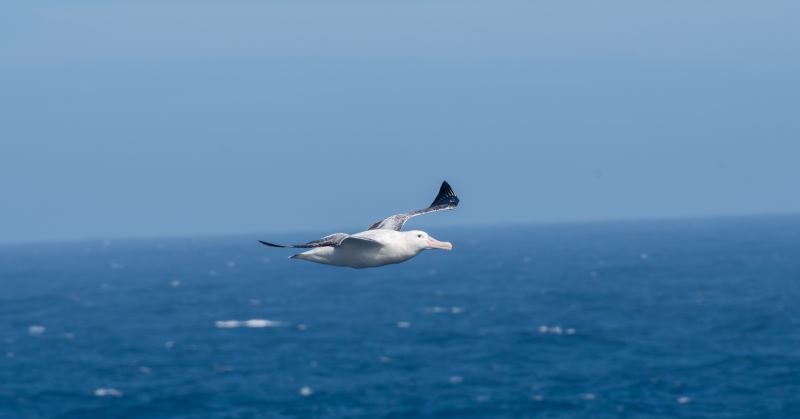
Hannah Buschert was first exposed to birds and birding during a required ornithology course at Oregon State University and she quickly caught the birding bug. This spurred her to pursue a career in environmental education and wildlife nature tourism as a park ranger in Texas and as the Great Florida Birding and Wildlife Trail Coordinator with Florida Fish and Wildlife. A family motel and passion for responsible ecotourism brought her home to the Oregon Coast where she and her husband, Erik, adventure and record a podcast (Hannah and Erik Go Birding), created in an effort to inspire others to get out and bird. Hannah is also a proud woman birder who advocates for others through her own podcast (Women Birders (Happy Hour)) and participation in activities, such as the Champions of the Flyway and the International Conference for Women Birders. This is Hannah’s first contribution to 10,000 Birds.
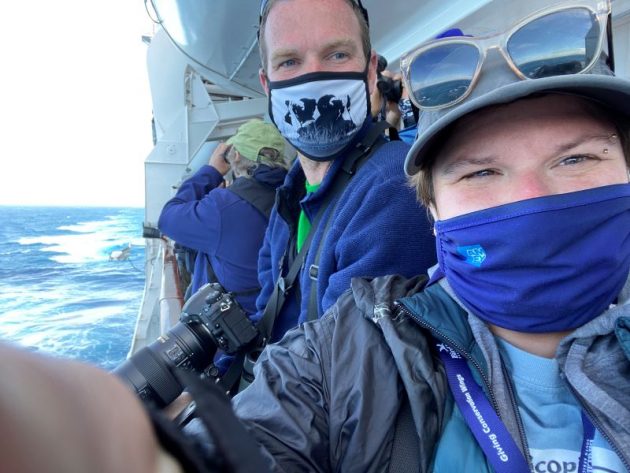 Hannah and Erik ready to see some birds!
Hannah and Erik ready to see some birds!
I love to go on cruises. Unlimited food, fully stocked bars, constant entertainment, lodging that moves about the world, and only unpacking and repacking once. Many birders actively avoid cruises, as they do not typically go to premier birding locations, and you often have to work harder than normal to find birds. But that is where Flock to Marion was different. It was a unique, once-in-a-lifetime opportunity to board a ship solely filled with birders to go to a destination that many will never have the chance to see – let alone bird.
Birdlife South Africa has previously done two of these types of trips before, previously called Flock to Sea – Namibia in 2013 and Flock to Nowhere in 2017, in partnership with MSC Cruises. It is an extremely popular fundraising project with an almost cult-like following. This is a cruise like no other, full of scientific lectures, over forty guides spread out on deck, bird-themed parties, and a lights-off mandate to protect birds at night.
The trip had initially been planned for January 2021, but due to COVID-19, it was delayed to January 2022. I learned of the trip right as it had been delayed and made a vow that I would be on that ship. So, I anxiously followed the “Flock to Marion 2022” Facebook group in anticipation for open cabins to come up for sale. I waited…and waited…and waited. It took months before the exciting announcement would come that all the 2021 reservations had been ported over to 2022 and any leftover cabins were for sale. Long story short, the only way I could figure out securing a cabin for myself and my husband, Erik, was to book a trip with Rockjumper, a birding tour company based in South Africa and a supporter of Birdlife South Africa. After securing our passage, I patiently waited for this once-in-a-lifetime experience to a place we have never been and lacked any knowledge of, we were in for a complete surprise.
 Salvin’s Prion
Salvin’s Prion
The Prince Edward Islands are two tiny chunks of land that most people will likely have never heard of. These two islands are about halfway between the tip of South Africa and Antarctica in the Subantarctic Indian Ocean, have had relatively few human visitors, and are primarily inhabited with some of the rarest seabirds in the world and a smaller number of mammals. South Africa is their steward and have been declared Special Nature Reserves under the South African Environmental Management: Protected Areas Act in 2003, which restricts activities on the islands to research and conservation management. The marine protected area status was designated in 2013.
The islands were discovered in 1663 by a Dutch East Indian Company ship, Maerseveen, but their coordinates were improperly recorded. The islands weren’t visited again until 1772 when a French explorer, Marc-Joseph Marion du Fresne, thought he had found Antarctica. In 1776, James Cook sailed past the islands due to charts and navigation of du Fresne’s second in command, Julien Crozet. None of the three voyagers made landfall due to poor weather and dangerous conditions. Finally in 1799, the first visitors on this volcanic land were a group of French seal hunters who were after the fur seals that can be found hauled out on the beaches for fur and oil, which almost wiped out the local population of the species.
In more recent history, two meteorological stations have been built on the island with the older dating back to 1948. These have been used by meteorologists, technicians, and researchers who spend about 13 months on the island at a time researching a variety of sciences. Prince Edward Island is about 45 km2 and Marion Island is much bigger at 295 km2 with 80km of coastline. It is still volcanically active with researchers periodically discovering new flows.
So, all this is to point out how particularly inaccessible and wondrous this place is. It has had very few humans walk its soil and who have had little impact to this otherwise pristine nature. Which makes it a haven for seabirds….and seabirders. About half of all breeding Wandering Albatross nest on the Prince Edward Islands. There’s also the Grey-headed Albatross, Sooty Albatross, Blue Petrel, Great-winged Petrel, Black-faced Sheathbill, and so many more that rely on this island. Also, many of which would be extremely difficult birds to see many other places in the world.
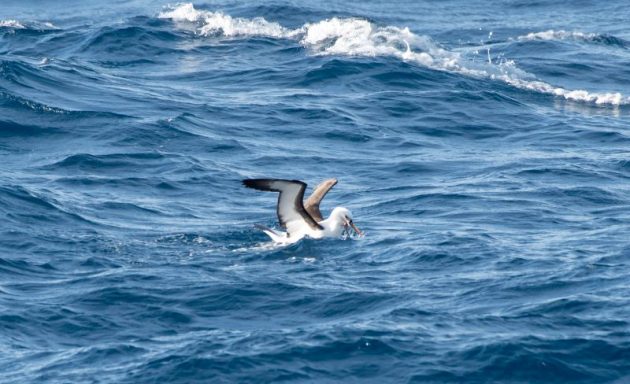 Yellow-nosed Albatross
Yellow-nosed Albatross
This cruise rose funds for the Mouse-free Marion project of Birdlife South Africa which will attempt to eradicate house mice from Marion Island. Although Prince Edward Island and Marion are close enough, only 21 km apart, Prince Edward is free of invasives, besides four plant species, so offers a great comparison for success.
Marion has a fascinating history with invasive species. The seal hunters accidentally introduced mice to Marion, as was the case for many islands around the world. When the base was built and managed by the South African government, the mice were found to be a minor nuisance so five cats were brought in to manage the mice population at the base. Well, cats are just as successful breeders as mice and soon there were thousands of cats that sought out prey bigger than mice and began to wipe out the native seabird population. The cats were eradicated by 1991, which left the mice population to go unchecked.
For many years, the birds and mice were able to live in a semi-stable harmony before something switched and caused news stories such as “The Zombie Mice of Marion Island”. The changing climate meant milder winters that kill off fewer mice and more mice meant more pressure on their food supply of vegetation and insects, such as the endemic flightless moth species, causing them to turn their appetites to the baby seabirds sitting helplessly all over the island. Several albatross nestlings were found having been ‘scalped’ by the mice leaving them to die a horrible death.
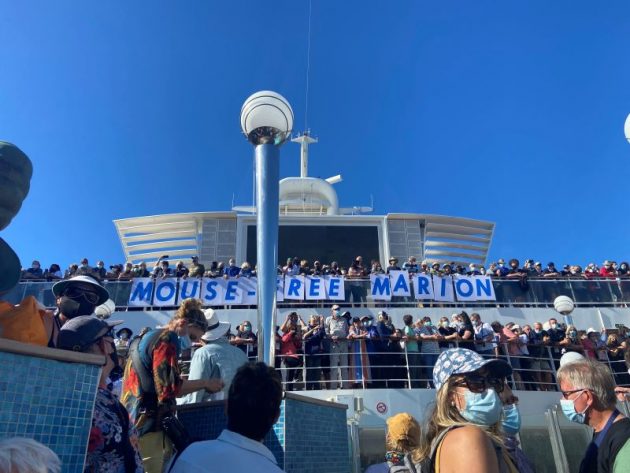 Mouse-free Marion!
Mouse-free Marion!
Fortunately, the solution to this issue is straightforward and can solve the problem almost immediately. Just get rid of the mice. For anyone that has had a mouse in their house – you will know that it is not that easy. However, Dr. Anton Wolfaardt and his team have developed a strategy based on similar projects that has been proven to work on islands around the world – cover the island with rodenticide-laced bait over several applications and pray to God that it reaches all the mice. You can hear more about that in this interview with Dr. Wolfaardt.
The cruise staff seemed utterly confused by us. Erik overheard a few waiters joke about the birders “…they keep going left, then right, left, then right.” And there were regular reminders to respect crew space and not run through the staff corridors. The first night on the ship, Erik and I went in search of the hopping bar…which we did not find. After looking through every bar, we concluded that all had abandoned the ship without warning us. Little did we know, they went to bed early to rise early. How was it that the 1,700 people aboard all had the same bedtime?
Birders are weird people; you cannot get around it. On a typical cruise, folks sleep in, have a lazy breakfast, sit by the pool with a cocktail, and watch the world-class entertainment. That is not the case on a birding cruise. We arose each morning at 4:30am to find out that we were late to the game. The rails were already filled with anxious birders armed with the latest and greatest in binoculars, cameras, and spotting scopes looking to add to their South Africa list, as many are members of the South African Listing Club, which is taken extremely seriously. And periodical “Bird Alert, Bird Alert” warnings over the ship’s PA system would cause mass movement of scopes, cameras, binoculars, and people in search of what was being called out.
The morning that we were slated to go approach Marion Island, Erik and I woke at 4:00am to get a good spot. We managed to wriggle in and find a few inches of railing where we had incredible views of Wandering Albatross soaring over the waves, Salvin’s Prions (a family of birds that Erik and I had never previously heard of) frantically flapping in large flocks of 50 or so just above the waves, and Great-winged Petrels with the sun gleaming off their silvery wings. And at this point, we had not even reached Prince Edward Islands and our target – Marion Island.
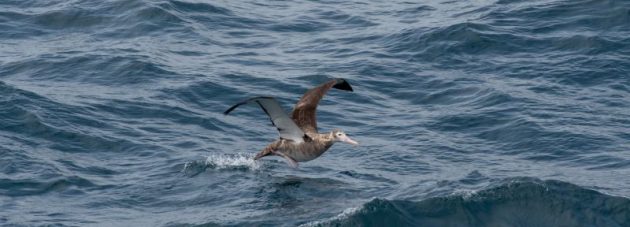 Wandering Albatross
Wandering Albatross
The minutes passed by so slowly as we sped towards our destination, but the birds were becoming more and more numerous. New species started to pop-up like our first sightings of Macaroni Penguins, Blue Petrel, and several prion species that were called out by our expert birding guides using loudhailers, or as we know them in the United States megaphones. These are some of the many species that breed on Marion and Prince Edward Islands which are targeted by the mice population.
Then, after days of cruising along on the wide, open ocean, someone sarcastically called out ‘land-ho!’ and we all turned to see the mountainous Prince Edward Island on the horizon. Penguins began to become numerous, and the anticipation turned into celebration as we saw our target. It was like a scene from a movie, birds called out by guides and participants swinging their binoculars to the designated angle. Wandering Albatross, Northern Giant Petrels, and Salvin’s Prions filled the space from sea to sky in a scene that looked more like an artist rendition than real life.
As with most pelagics, we used the clock system with 12:00 as the bow and 6:00 as the stern to direct sightings. However, when using this method on a large cruise ship, there are times when you are at 9:00 and a bird is being seen at 3:00, you might have to run through the casino to get there and will likely have missed the bird. Do not even think about it when the bird is being seen off the stern, you are on deck seven and have to traverse six flights and fight your way through the buffet to get there – not your typical challenge on a pelagic.
Throughout our six hours in Prince Edward Islands waters, we spent our time carefully scrutinizing every bird, birders took unofficial shifts to wander in to quickly refuel with coffee and food, a sense of excitement clung in the air. Every bird was observed, the ocean scoured for the slightest movement of penguins, and we squinted into the distance to burn the image of the foggy islands into our memory – a place that few will ever get to see. We left early to head back to Durban as a storm system was on the horizon that caused a rocking return ride on the Southern Antarctic Ocean with 80 mph winds, “the roughest, stormiest ocean of the world,” described by famed seabirder, Peter Harrison.
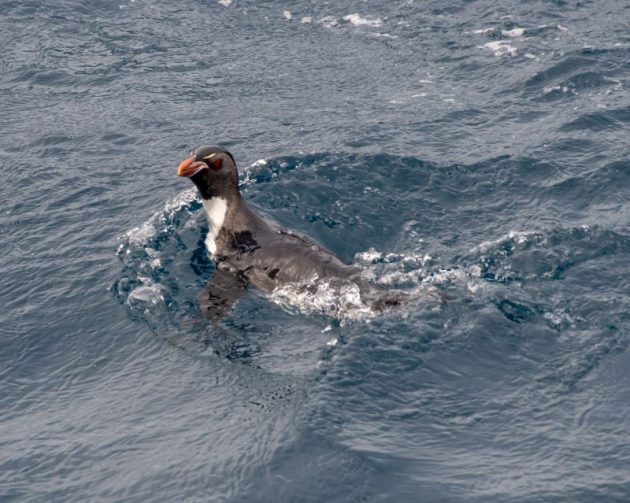 Southern Rockhopper Penguin
Southern Rockhopper Penguin
The three-day cruise home was much more relaxed as many recounted tales of sightings and birds seen from the ship. And I finally had my “Attu moment” when the ship’s PA announced, “a Tristan Albatross has been seen off the stern. If you get a chance to see it, please move off the rail to give others a chance”. A Tristan Albatross, which according to Clements is a subspecies of Wandering Albatross – but, is a full species according to IOC which most South Africans use. Birders flocked to the back of the ship to see this aberrant albatross and the sound of camera shutters snapping at lightning speed filled the air.
The trip was everchanging: Birdlife South Africa continuously petitioned the South African government for a permit to get close access to these islands as they are a Marine Protected Area which was denied in part due to the precedent that might set for other cruise lines; we were initially slated to be within the presence of the Prince Edward Islands for approximately 24-hours, which was eventually shortened to just six hours because of impending storm fronts that chased us away and made the ship rock to a point where they had to close elevators due to potential danger. Regardless, we made it Marion and all else added to the experience. It also showed us the unpredictability of the rugged Southern Ocean which makes me respect the species that make their home in this inhospitable landscape that much more. Although we could not see the cliffs, grasslands, and lava flows that make up Marion Island, researchers shared pictures in their lectures that build the whole story, so I feel as if I have been there.
I think a lot about shared experiences and how they bring unlikely people together, such as birding tours, festivals, conferences. Our Flock to Marion was no different. The morning in which we were destined to see Marion Island after all this time planning, travel, and sea voyage, I was worried that leaving the destination would create a huge let-down. During college, I worked weddings as a cater waiter and watched a number of brides who sat down after the reception and cried because it was all over. All that planning, preparation, shopping, organizing, and now it was over. Surprisingly, I did not feel that way after the six hours that we skirted the boundary of Marion Island were up and the island was in the metaphorical review-view mirror. Instead, I reflected on this incredible adventure and the amazing opportunity afforded me by Birdlife South Africa and partners. This was truly a once-in-a-lifetime experience that the some-1,480 participants would not forget and has inextricably linked us as the ones who went on Flock to Marion. To paraphrase Robert Cushman Murphy, “I now belong to a higher cult of mortals for I have seen Marion Island.”
Thanks to Birdlife South Africa, MSC Cruises, Mouse-free Marion, and Rockjumper for the fabulous time aboard the MSC Orchestra and visit to Marion Island. It was truly an honor to be on board learning, interacting, and enjoying with you all. Not only did we get an opportunity to see incredible birds that many will never add to their life list, but we also were able to contribute to the conservation of these species.
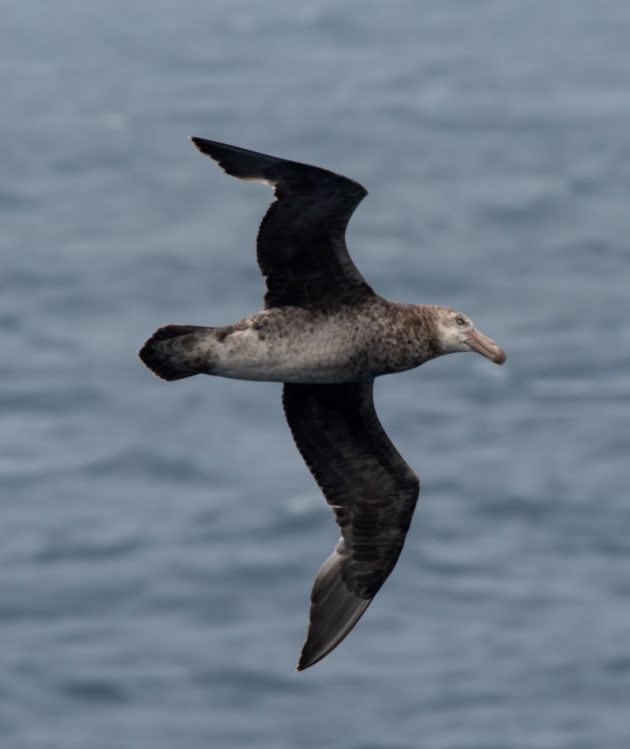 Northern Giant-Petrel
Northern Giant-Petrel













Awesome trip! The invasive mouse issue is in the US too:
https://www.10000birds.com/for-the-birds-midway-atoll-mouse-eradication-and-nepa.htm
Awesome recounting of this once in a lifetime experience. I hope to make it on the next Flock where ever it ends up going.
Great story, loved it! Please do write some more.
Thank you for telling the story. I wanted to take that trip, but schedule did not permit.